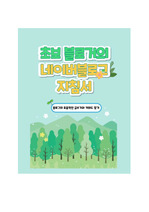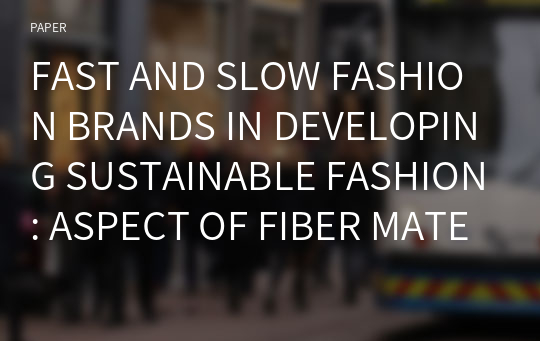FAST AND SLOW FASHION BRANDS IN DEVELOPING SUSTAINABLE FASHION: ASPECT OF FIBER MATERIALS
* 본 문서는 배포용으로 복사 및 편집이 불가합니다.
서지정보
ㆍ발행기관 : 글로벌지식마케팅경영학회(GFMC)
ㆍ수록지정보 : GFMC Session1
ㆍ저자명 : Mijeong Noh, Jessica Carroll, Sierra Holt, Kristeena Blaser
ㆍ저자명 : Mijeong Noh, Jessica Carroll, Sierra Holt, Kristeena Blaser
영어 초록
Introduction The current fashion industry has been overrun with fast fashion products in the last couple of decades. Consequently, it has become one of the most environmentally degrading industries worldwide, and is plagued by social and economic inequalities (Fletcher, 2013). The fast fashion apparel industry produces pollution and waste; and wearers are exposed to hazardous materials. The fast pace of the fashion industry has also led to unsafe working conditions that can result in detrimental influence on workers as in the 2013 Rana Plaza collapse in Dhaka, Bangladesh. Furthermore, the individuals responsible for making the fast fashion products often live in underdeveloped countries and are paid below national minimum wage (Niinimaki, 2013). In contrast, the sustainable fashion industry aims to produce safer, cleaner, and more impactful apparel. A part of the growing sustainable apparel industry is slow fashion, which emphasizes creating fashion products at a less-intensive pace with environmentally-minded techniques. Slow fashion movement is an emerging trend within the fashion industry that counteracts the harms of fast fashion. The term „slow fashion‟ was first used by Kate Fletcher and shares several characteristics with slow food, from which the slow fashion movement got much of its inspiration (Cataldi, Dickson, & Grover, 2010). Slow fashion is thought to represent a blatant discontinuity such as a break from the values and goals of fast (growth-based) fashion (Fletcher, 2013). Slow fashion attempts to remedy the various negative economic, social, and environmental global impacts of the current fast fashion system. The purpose of this study was to analyze the material-oriented trends of representative fast fashion and slow fashion brands toward the development of sustainable fashion. This study aimed to answer the following questions: 1) By what efforts in terms of material usage do the fast and slow fashion brands promote sustainable fashion? and 2) How do these efforts influence apparel manufacturing as sustainability practices and consumers‟ purchase intentions? Backgrounds Moore and Fernie (Moore & Fernie, 2004, p. 31) defined fast fashion as “various strategies to respond commercially to the latest fashion trends”. Fast fashion brands, such as H&M, Forever 21, and Zara, use a combination of quick response and enhanced design techniques to quickly design, manufacture, and stock trendy apparel and accessories that consumers can purchase at an affordable price (Cortez et al., 2014). The manufacturers of fast fashion brands struggle to provide innovative merchandise in their preferred production timetable (Cortez et al., 2014). In such an overloaded manufacturing process, the apparel industry has experienced increased pollution and hazardous work environments. Slow fashion is defined as “a philosophy of attention that is sensitive to environmental and societal needs and to the impact production and distribution have on society and the environment” (Karaosman, Brun, & Morales-Alonso, 2016). Antanaviciute and Dobilaite (2015) report that the slow fashion industry is sustainable and seeks a greater purpose than making profit, and is thus characterized with promoting fair economic, environmental, and social systems within the fashion cycle. In the slow fashion movement, the materials used to produce garments are environmentally friendly. Sustainable fashion is achieved when available materials are used to their ultimate potential; waste materials are utilized; the products are recycled; and a second life for the fashion products is planned (Sharda & Mohan Kumar, 2012). In addition, sustainable fashion uses biodegradable materials such as organic cotton, polylactic acid, and other biopolymers etc. (Fletcher, 2013). In the production phase, garments workers who produce sustainable fashion products are paid a living wage, unlike their counterparts who work for less than a dollar a day in the fast fashion industry. Throughout the slow fashion supply chain, reducing the speed at which the products are produced and consumed is emphasized. Slowing down the production phase results in end products of better materials, with more material-construction input-time, and longer-lasting overall final product, as compared to typical fast fashion items. Case study This study was conducted based on a case study. We analyzed the sustainability practices in aspect of fiber materials of two representative brands: a fast fashion, Zara and a slow fashion, People Tree. Several resources were used to collect the information necessary for the case study. The primary resources were academic articles, reports, and brochures from companies‟ websites. The information on both companies was very useful to understand their products and sustainability practices as a fast fashion and a slow fashion brand. Zara is a ready-to-wear fast fashion retailer based in Spain, which was created by Rosalia Mera and Óscar Pérez Marcote in 1974. Since its creation, the fast fashion retailer has built a reputation for manufacturing and stocking on-trend clothing at the customer‟s demand. The company sends small shipments year-round to stores and subsequently monitors the customers‟ reactions by adjusting the store inventory. The retail giant has employed over 10,000 employees and is a private company that, according to the Business of Fashion, was worth $16.7 billion in 2013 (Hansen, 2012). Zara is known as affordable luxury (Gamboa & Goncalves, 2014) for its on-trend imitations of high-end clothing pieces that are inexpensive. The average Zara consumer is young with an age range of 18 to 24 years and female (Gamboa & Goncalves, 2014). Zara was chosen for this case study based on its unique and successful fast fashion business model. Zara has been criticized for numerous violations in manufacturing practice, including a lack of hygiene and safety in its Argentinian factories. The workers‟ rights NGO La Alameda, alleged that the working conditions consisted of no breaks and poorly lit and unventilated conditions (Crotty, 2013). The company compensated the workers and was forced to pay $530,000. People Tree is considered as a pioneer in the slow fashion movement and sustainable fashion. The company has implemented many measures to increase its economic, social, and environmental sustainability. People Tree was the first fashion brand to develop an integrated supply chain for organic cotton from the farm to the final product. Furthermore, they were the first organization to achieve a Global Organic Textile Standard certification. They source their yarns, fabrics, and accessories locally, as well as choose natural and recycled products over the toxic, synthetic, and non-biodegradable materials typically found in fast fashion products. The People Tree producer group is comprised of over 4,560 artisan producers, which includes hand weavers, hand knitters, embroiderers, tailors, and group leaders. They allow local individuals to produce and create incredibly unique products, thus generating livelihoods and incomes for these individuals who typically reside in very rural areas. Zara uses a variety of synthetic and organic fibers and textiles in its clothing. Zara partners with a company called Lenzing to source recycled polyester, cotton, and wool when available, and then donates any extra textiles not used in manufacturing products. Zara prioritizes using organic cotton and recycled materials. Organic cotton is grown and manufactured without harmful pesticides. Zara has become one of the biggest users of organic cotton, which is a part of their Join Life campaign and in collaboration with the Better Cotton Initiative (Inditex Annual Report, 2016). Zara also uses three types of rayon in its products: Modal, Viscose, and Lyocell. These materials are made from cellulose fibers, which take longer to harvest and manufacture than cotton. People Tree does not use polyester in its products, and most of its clothing is made from organic cotton and wool. It uses 100% fair-trade certified organic cotton that is certified by Soil Association (People Tree Seventh Biennial Social Review, 2011-2012). In addition to cotton and wool, it uses a fiber called “Tencel,” which is made from wood pulp. Tencel is a Lyocell product, also made from cellulose fiber, which is stretch-resistant and highly versatile. Zara uses both synthetic and organic fibers; whereas, People Tree uses organic fibers in the manufacturing of products. Lyocell is one of the most revered sustainable fibers currently on the market. Lyocell is a cellulosic fiber, specifically derived from wood pulp, normally eucalyptus (Fletcher, 2013), beech, and pine (Gordon & Hill, 2015). In a typical process, the wood pulp is dissolved in a solution of amine oxide, a solvent, which is then spun into fibers; subsequently, the solvent is removed from the fibers through a washing process (Fletcher, 2013). The manufacturing process recovers 99.5% of the solvent and the solvent is recycled back into the process (Fletcher, 2013). The solvent is non-toxic, non-corrosive, and all effluent is non-hazardous (Fletcher, 2013). Lyocell has many other environmental benefits such as complete biodegradability (six weeks in an aerated compost heap), and of renewable raw material (eucalyptus has a fast-growing cycle and reaches full maturity in seven years). No bleaching is used prior to processing the fiber, thus reducing chemical, water, and energy consumption in the dyeing process; hence, Lyocell is considered as a “very clean” fiber (Fletcher, 2013). While Lyocell is considered a very sustainable product, its production is energy intensive. However, due to recent research, the amount of energy used to make Lyocell has begun to decrease (Fletcher, 2013). Lyocell is also known by its brand name, Tencel (Gordon & Hill, 2015). Companies such as People Tree have begun to use products like Tencel in their everyday-clothing production. People Tree‟s “Our Tencel” collection is produced by Creative Handicrafts, a social enterprise working to actively empower disadvantaged women of the slum communities of Mumbai through economic independence. Like every producer of People Tree‟s clothing or Tencel products, Creative Handicrafts works to provide fair pay and safe treatment for all their workers. They also work to improve the lives of those employed by Creative Handicrafts. People Tree is currently using their “Our Tencel” collection to upskill the workers, making them qualified for higher paying and more difficult jobs should they choose to leave Creative Handicrafts. They aim to provide workers with a greater range of fabrics that they can work with for future client‟s needs. This provides the workers with greater business opportunities. The slow fashion brand‟s attributes attract ethical consumers. The ethical consumer considers the impact of consumption in terms of environmental and social responsibilities (Barnett et al., 2005). The likeliness of ethical consumer‟s purchasing or willing to purchase a slow fashion product depends on the customer‟s level of involvement. A consumer with high involvement who is willing to purchase the product at a higher price, is not attracted to mass fashion trends, and shows intent to purchase an apparel product for environmental reasons (Jung & Jin, 2016). McNeil and Moore (McNeil & Moore, 2015) found correlations between concern levels for both environmental and social wellbeing and consumer‟s intentions towards sustainable apparel. Similarly, it is possible to predict the preference of ethical consumers to purchase a fast fashion product if made of sustainable fiber materials. Conclusions We analyzed the material-oriented trends of representative fast fashion brand, Zara, and slow fashion brand, People Tree, toward development of sustainable fashion. The kinds of materials used by each brand in manufacturing fashion products, and recent efforts in sustainable practices of both fashion brands were analyzed. The results indicated that the fast fashion brand, Zara has begun to incorporate sustainable fibers such as organic cotton into their products, and the slow fashion brand, People Tree uses more sustainable fibers such as Tencel and organic cotton for its garments and other products. The efforts involved in the trends of fast and slow fashion brands toward sustainable fashion were anticipated to attract ethical consumers‟ purchase intentions. The current findings suggested that new technology offers innovative manufacturing processes producing more eco-friendly products, less waste, and less pollution, which begins to mitigate the negative environmental effects of the traditional fast fashion industry. Implications and limitations This study was intended to analyze the efforts involved in the production of fast fashion and slow fashion brands in aspect of fiber materials, toward the overall goal of sustainable practices. This study may be useful to designers, manufacturers, and retailers who hope to better understand the trend of sustainable practices of both fast and slow fashion brands. Since ethical consumers presumably prefer sustainable products, this study may help designers, manufacturers, and retailers establish optimized strategies tailored to such trends. This study has a limitation due to selection of a small number of brands, which prevents the generalization of the results to all fast and slow fashion brands.참고 자료
없음"GFMC Session1"의 다른 논문
 “WHAT IF A CELEBRITY AND A BRAND CO-CREATE A NEW COLLEC..7페이지
“WHAT IF A CELEBRITY AND A BRAND CO-CREATE A NEW COLLEC..7페이지 THE INSTAGRAM’S STRATEGY IN ENGAGING THE CUSTOMER’S LOY..3페이지
THE INSTAGRAM’S STRATEGY IN ENGAGING THE CUSTOMER’S LOY..3페이지 THE PARTICULARITIES OF NEW PRODUCT DEVELOPMENT IN THE T..5페이지
THE PARTICULARITIES OF NEW PRODUCT DEVELOPMENT IN THE T..5페이지 THE LONE CHOCOLATE BAR: THE INFLUENCE OF PERCEIVED SCAR..6페이지
THE LONE CHOCOLATE BAR: THE INFLUENCE OF PERCEIVED SCAR..6페이지 ADS AS WORKS OF ART: MEASURING ADVERTISING IMMERSION3페이지
ADS AS WORKS OF ART: MEASURING ADVERTISING IMMERSION3페이지 ECONOMIES OF SMALL: NICHE STRATEGIES AND SUCCESS FACTOR..8페이지
ECONOMIES OF SMALL: NICHE STRATEGIES AND SUCCESS FACTOR..8페이지 THE INFLUENCE OF ONLINE CUSTOMER REVIEWS ON RETAILERS' ..6페이지
THE INFLUENCE OF ONLINE CUSTOMER REVIEWS ON RETAILERS' ..6페이지 IS THE ARTIFICATION PROCESS PERCEIVED BY FINAL CONSUMER..6페이지
IS THE ARTIFICATION PROCESS PERCEIVED BY FINAL CONSUMER..6페이지 THE ODD EVEN PRICE PARADOX IN THE FASHION LUXURY SECTOR6페이지
THE ODD EVEN PRICE PARADOX IN THE FASHION LUXURY SECTOR6페이지 CONCEPTUALISING BEAUTY IN CONSUMER RESEARCH: A FRAMEWOR..8페이지
CONCEPTUALISING BEAUTY IN CONSUMER RESEARCH: A FRAMEWOR..8페이지


























